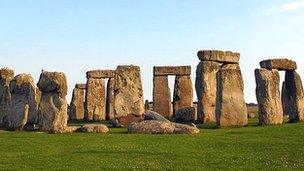Stonehenge should display fake human remains, druid says
- Published

English Heritage plans to display the remains at the new Stonehenge visitor centre
A druid leader is calling for fake, rather than real, human remains to be put on display at Stonehenge.
In an open letter, King Arthur Pendragon criticised English Heritage for the "macabre manner" it plans to display "ancestral remains".
In 2011, he lost a High Court bid to have bones, found in 2008, reburied.
English Heritage said the remains were not from the 2008 excavation and their "presentation, treatment and storage" would follow strict UK guidelines.
The cremated remains of more than 40 bodies, thought to be at least 5,000 years old, were removed from a burial site at the ancient stone circle five years ago.
According to Mr Pendragon, the bones were the remains of members of the "royal line" or "priest caste" who could have been the "founding fathers of this great nation".
"There are cremated remains and a full skeleton from one of the barrows, which they're planning to put on display," he said.
"This is not only out of step with the feelings of many of the peoples and groups that I represent but is surely against the driving cultural principles of a Unesco World Heritage Site."
The £27m scheme to build a new visitor centre and close the road alongside the ancient monument, is due to be completed by the end of the year.
Mr Pendragon said visitors would be "appalled" and unless "models and replicas" were used he could "not rule out non-violent direct action against the proposals".
'Visitors expect remains'
But a spokeswoman for English Heritage said visitor research showed the "vast majority of museum visitors are comfortable with, and often expect to see, human remains".
"The remains of three human burials found in the landscape will be displayed with ample explanation along with archaeological objects, providing visitors with a direct connection to the people who lived and worked there," she said.
"As such, we believe they have a rightful place in the exhibition and their presentation, treatment and storage will follow strict guidelines set out by the UK government's Department of Culture, Media and Sport."
- Published19 February 2013
- Published11 July 2012
- Published24 August 2011
- Published23 August 2011